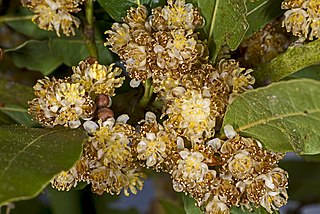
The Laurales are an order of flowering plants. They are magnoliids, related to the Magnoliales.

Nothofagus, also known as the southern beeches, is a genus of 43 species of trees and shrubs native to the Southern Hemisphere in southern South America and east and southeast Australia, New Zealand, New Guinea, and New Caledonia. The species are ecological dominants in many temperate forests in these regions. Some species are reportedly naturalised in Germany and Great Britain. The genus has a rich fossil record of leaves, cupules, and pollen, with fossils extending into the late Cretaceous period and occurring in Australia, New Zealand, Antarctica, and South America.
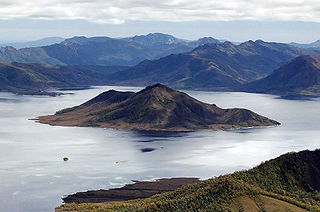
The Tasmanian temperate rain forests are a temperate broadleaf and mixed forests ecoregion in western Tasmania. The ecoregion is part of the Australasian realm, which includes Tasmania and Australia, New Zealand, New Guinea, New Caledonia, and adjacent islands.
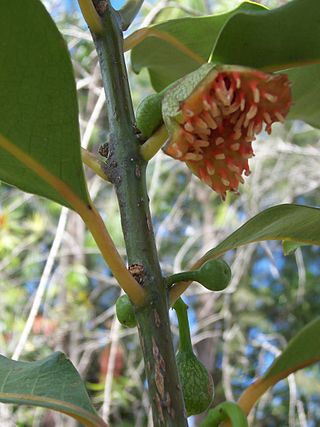
The Monimiaceae is a family of flowering plants in the magnoliid order Laurales. It is closely related to the families Hernandiaceae and Lauraceae. It consists of shrubs, small trees, and a few lianas of the tropics and subtropics, mostly in the southern hemisphere. The largest center of diversity is New Guinea, with about 75 species. Lesser centres of diversity are Madagascar, Australia, and the neotropics. Africa has one species, Xymalos monospora, as does Southern Chile. Several species are distributed through Malesia and the southwest Pacific.

The biodiversity of New Caledonia is of exceptional biological and paleoecological interest. It is frequently referred to as a biodiversity hotspot. The country is a large South Pacific archipelago with a total land area of more than 18,000 square kilometres (6,900 sq mi). The terrain includes a variety of reefs, atolls, small islands, and a variety of topographical and edaphic regions on the largest island, all of which promote the development of unusually concentrated biodiversity. The region's climate is oceanic and tropical.
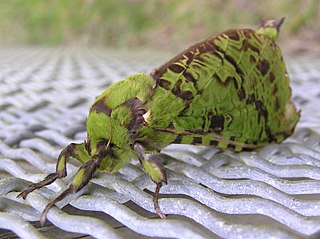
Aenetus is a genus of moths of the family Hepialidae. There are 24 described species found in Indonesia, New Guinea, New Caledonia, Australia and New Zealand. Most species have green or blue forewings and reddish hindwings, but some are predominantly brown or white. The larvae feed in the trunks of living trees, burrowing horizontally into the trunk, then vertically down.

Laurelia sempervirens is a species of evergreen tree in the family Atherospermataceae. Common names include Peruvian nutmeg, tihue or trihue, and Chilean laurel or Chilean sassafras.

Laurelia is a genus of plant in the major group Angiosperms in the family Atherospermataceae, or formerly Monimiaceae. It contains only two species, both endemic to the southern hemisphere, an example of Gondwanan distribution.
The natural history of New Zealand began when the landmass Zealandia broke away from the supercontinent Gondwana in the Cretaceous period. Before this time, Zealandia shared its past with Australia and Antarctica. Since this separation, the New Zealand landscape has evolved in physical isolation, although much of its current biota has more recent connections with species on other landmasses. The exclusively natural history of the country ended in about 1300 AD, when humans first settled, and the country's environmental history began. The period from 1300 AD to today coincides with the extinction of many of New Zealand's unique species that had evolved there.

Laurelia novae-zelandiae, also called pukatea, is a large evergreen tree, endemic to the forests of New Zealand. Pukatea has 'toothed' leaves and produces small flowers. It is a species in the Atherospermataceae family, typical representative of laurel forest ecoregion.

Atherosperma moschatum, the southern sassafras or blackheart sassafras, is an evergreen tree native to the cool temperate rainforests of Tasmania, Victoria, and New South Wales in Australia. It is common in the rainforests of Tasmania and Victoria, but more scattered and rare in the higher altitudes of eastern New South Wales. The northernmost area is at Mount Grundy, west of Port Macquarie.

Doryphora is a genus of plant in the family Atherospermataceae, or formerly Monimiaceae. It contains four species, two endemic to Australia and two to New Caledonia.

Doryphora sassafras, commonly known as sassafras, yellow-, canary- or golden sassafras, or golden deal, is a species of evergreen tree of the family Atherospermataceae native to the subtropical and temperate rainforests of eastern New South Wales and Queensland, Australia. It is a tall tree with green foliage and contrasting white flowers which occur in Autumn and Winter.

Daphnandra johnsonii, also known as the Illawarra socketwood, is a rare rainforest tree in the Illawarra district of eastern Australia.
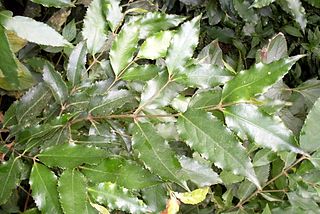
Daphnandra is a genus of shrubs and trees in the family Atherospermataceae, or formerly Monimiaceae. The genus is endemic to Australia.
Banksia novae-zelandiae is an extinct species of Banksia, known only from fossil leaves found in the South Island of New Zealand.

Atherosperma moschatum subsp. integrifolium is a small evergreen tree native to the temperate rainforests of central and northern New South Wales, Australia. In 2006, it was recognised as a separate subspecies by Richard Schodde. Common names include "southern sassafras - narrow leaf form" and "blackheart sassafras".
Pannaria phyllidiata is a species of lichen in the family Pannariaceae. Known from Australia, it was described as new to science in 2011. It is characterised by its unique phyllidia and distinct distribution.

Rainforests and vine thickets are a major vegetation group in Australia. It consists of temperate to tropical rainforests, monsoon forests, and vine thickets. Rainforests and vine thickets are generally found in small pockets across the eastern and northern portions of the continent, including western Tasmania, eastern New South Wales, eastern Queensland, the northern portion of the Northern Territory, and the Kimberley Region of northeastern Western Australia.















